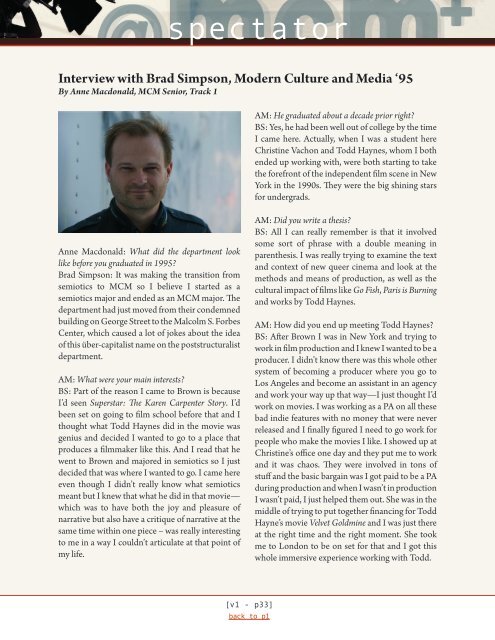You also want an ePaper? Increase the reach of your titles
YUMPU automatically turns print PDFs into web optimized ePapers that Google loves.
spectator<br />
Interview with Brad Simpson, Modern Culture and Media ‘95<br />
By Anne Macdonald, MCM Senior, Track 1<br />
AM: He graduated about a decade prior right?<br />
BS: Yes, he had been well out of college by the time<br />
I came here. Actually, when I was a student here<br />
Christine Vachon and Todd Haynes, whom I both<br />
ended up working with, were both starting to take<br />
the forefront of the independent film scene in New<br />
York in the 1990s. They were the big shining stars<br />
for undergrads.<br />
Anne Macdonald: What did the department look<br />
like before you graduated in 1995?<br />
Brad Simpson: It was making the transition from<br />
semiotics to MCM so I believe I started as a<br />
semiotics major and ended as an MCM major. The<br />
department had just moved from their condemned<br />
building on George Street to the Malcolm S. Forbes<br />
Center, which caused a lot of jokes about the idea<br />
of this über-capitalist name on the poststructuralist<br />
department.<br />
AM: What were your main interests?<br />
BS: Part of the reason I came to <strong>Brown</strong> is because<br />
I’d seen Superstar: The Karen Carpenter Story. I’d<br />
been set on going to film school before that and I<br />
thought what Todd Haynes did in the movie was<br />
genius and decided I wanted to go to a place that<br />
produces a filmmaker like this. And I read that he<br />
went to <strong>Brown</strong> and majored in semiotics so I just<br />
decided that was where I wanted to go. I came here<br />
even though I didn’t really know what semiotics<br />
meant but I knew that what he did in that movie—<br />
which was to have both the joy and pleasure of<br />
narrative but also have a critique of narrative at the<br />
same time within one piece – was really interesting<br />
to me in a way I couldn’t articulate at that point of<br />
my life.<br />
AM: Did you write a thesis?<br />
BS: All I can really remember is that it involved<br />
some sort of phrase with a double meaning in<br />
parenthesis. I was really trying to examine the text<br />
and context of new queer cinema and look at the<br />
methods and means of production, as well as the<br />
cultural impact of films like Go Fish, Paris is Burning<br />
and works by Todd Haynes.<br />
AM: How did you end up meeting Todd Haynes?<br />
BS: After <strong>Brown</strong> I was in New York and trying to<br />
work in film production and I knew I wanted to be a<br />
producer. I didn’t know there was this whole other<br />
system of becoming a producer where you go to<br />
Los Angeles and become an assistant in an agency<br />
and work your way up that way—I just thought I’d<br />
work on movies. I was working as a PA on all these<br />
bad indie features with no money that were never<br />
released and I finally figured I need to go work for<br />
people who make the movies I like. I showed up at<br />
Christine’s office one day and they put me to work<br />
and it was chaos. They were involved in tons of<br />
stuff and the basic bargain was I got paid to be a PA<br />
during production and when I wasn’t in production<br />
I wasn’t paid, I just helped them out. She was in the<br />
middle of trying to put together financing for Todd<br />
Hayne’s movie Velvet Goldmine and I was just there<br />
at the right time and the right moment. She took<br />
me to London to be on set for that and I got this<br />
whole immersive experience working with Todd.<br />
[v1 - p33]<br />
back to p1
















